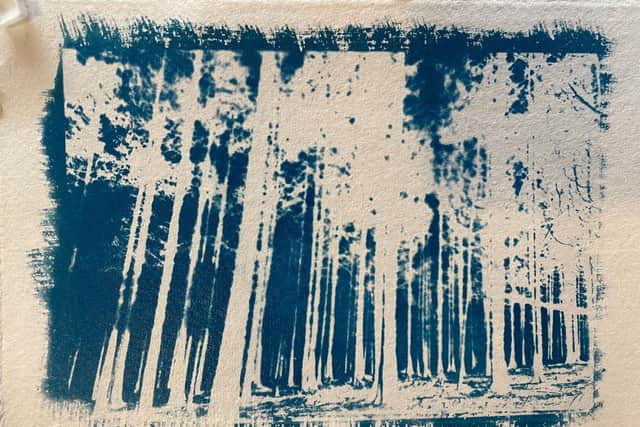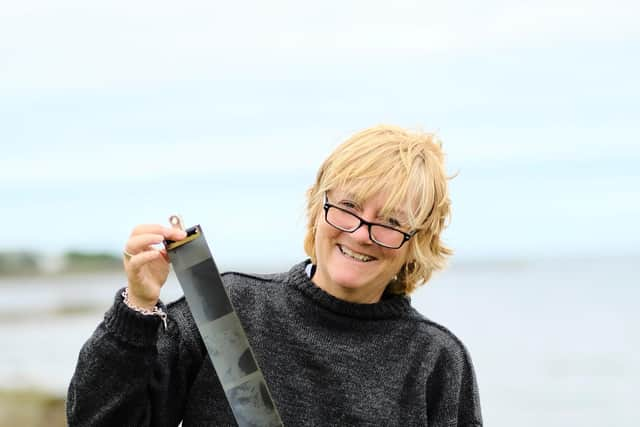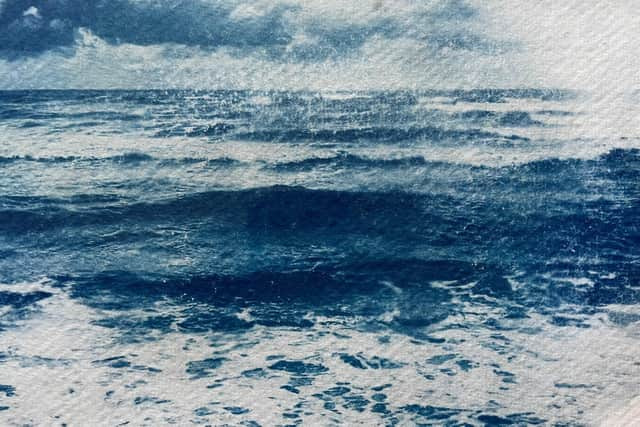Photographer talks about adapting old techniques with 21st century digital methods
and live on Freeview channel 276
“I can recall the first time I saw a print develop in a tray in the attic, and I’ve been hooked ever since,” the photographer said.
“It is alchemy. And I love cameras of every sort, and paper. So it was always going to happen.”
Advertisement
Hide AdAdvertisement
Hide AdNow Ali uses 19th century photographic techniques to develop her pictures.


The technique, known as cyanotype, uses salts to coat a light-sensitive emulsion onto paper, and this is then exposed to sunlight or UV.
Ali explains that there are many ways in which the emulsion can be applied, and different emulsion recipes give form to different techniques.
She said: “I work mainly with the cyanotype method which gives familiar Prussian Blue prints.
Advertisement
Hide AdAdvertisement
Hide Ad“This was developed by Herschel in 1842 and is a simple method that is very satisfying to work with. Coating papers in my dimroom makes me happy.”


The reason for using this different method to process the pictures stemmed from Ali’s interest in the way early photographic techniques can be adapted to make use of 21 century digital methods.
She explained: “I print negatives using the Inkjet printer and use these to contact print images.”
The 2020 lockdown gave Ali the time to explore the technique of cyanotypes more fully.
Advertisement
Hide AdAdvertisement
Hide AdShe said: “I spent a lot of time in lockdown working on creative projects that interested me when running photography tours to India was not possible.


“Cyanotypes have been on my radar for a long time, but it came up again as a form of photography that allowed me to roll up my sleeves and ‘paint’ as well as make photographic images.”
Describing the process Ali says that most people have had a go with them at school as sunprints, by placing objects on special paper and exposing the paper to sunlight to create the image.
Much of Ali’s work features places close to where she lives in Bosham.
Advertisement
Hide AdAdvertisement
Hide AdShe said: “I have a deep relationship with the ecology of Chichester Harbour, in particular the sea and the trees in the landscape, and I found that trees in the Harbour have a great resonance when printed as a cyanotype.
“There is an upswell in interest in alternative photography that I am involved with, a slow response to the immediacy of digital photography.
“People like to find their craft and cyanotype techniques speak to this need.”
Exploring environmental themes from behind the lens of a camera is very much the ethos of Ali’s work having studied a PhD in environmental geography.
Advertisement
Hide AdAdvertisement
Hide AdShe said: “I have a deep interest in ecological communities and how ecosystems connect.”
The pieces she is working on at the moment also have a number of related themes to the environment, including the Skeletons of Waste, an examination of waste found on Chichester Harbour and photographed in a studio setting.
A parallel series examines the botanical dying of cyanotypes with foraged plants that change the tones from blue to deep greens and rich chocolate browns, where the botanical image is also the dyebath. A mushroom image, toned with mushroom stock, made from the mushroom in the photograph.
She said: “I like the circularity of ideas. I have a sustainable, ecological footprint with kitchen chemistry that can be flushed down the drain.
Advertisement
Hide AdAdvertisement
Hide Ad“I actively work in slow, thoughtful photography. I call my botanical cyanotypes Foraged Photographs, to differentiate them from my black and white fine art photographic images.”
Looking after the environment and being more mindful about what she uses is also important to Ali.
As part of her studio footprint the Khadi paper Ali uses is made from recycled paper and is robust enough for a water wash and dye bath.
She found that some papers collapse in a heap during that process and can’t be used for the early photographic techniques such as the cyanotypes.
Advertisement
Hide AdAdvertisement
Hide AdAli is also keen to share her passion and skills with others by holding workshops in her studio in Hambrook and on the Harbour at Chichester.
Two or three workshops run a month and she teaches both adults and children aged ten and up.
She said: “I support both digital camera workshops, editing sessions and alternative photography workshops. I am interested in creative outcomes supported by technique.
“An important element of my workshops is to create learning environments that take complex ideas and make them accessible. I also think a tasty home-made lunch and lots of fun on the way are important!
Advertisement
Hide AdAdvertisement
Hide Ad“I firmly believe there is no substitute for experience so we also work in the field on various exercises that free up creativity through developing technical skills.
“In the various alternative photography workshops, creativity is only limited by imagination. I aim to help people be brave enough to release their inner creative monkeys.”
The Harbour Safari in the spring, will be working with cyanotypes, but Ali can also offer bespoke workshops tailored to your interests and needs, individual or group.
Describing herself as having a low boredom threshold Ali says that ‘the project nature of photography’ suits her.
Advertisement
Hide AdAdvertisement
Hide AdAnd it is clear when talking to Ali that she still gets that same buzz from photography that she did when she first started out working in her godfather’s dark room.
“I can work on a commission or do a portrait photoshoot and still have the buzz every time I look through the lens,” she explained.
“Having my own studio allows me to work on creative series that hold my attention as well as being a great space to teach workshops.”
For anyone interested in viewing Ali’s work there are prints for sale on my website that are hand-printed to order and she is available for fine art commissions.
For more information, visit www.aliwarnerphotography.com
Comment Guidelines
National World encourages reader discussion on our stories. User feedback, insights and back-and-forth exchanges add a rich layer of context to reporting. Please review our Community Guidelines before commenting.
